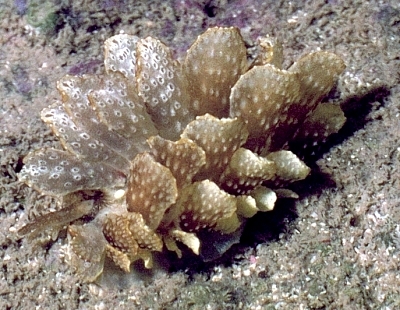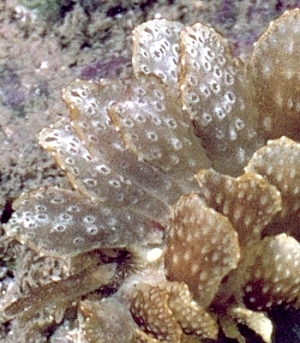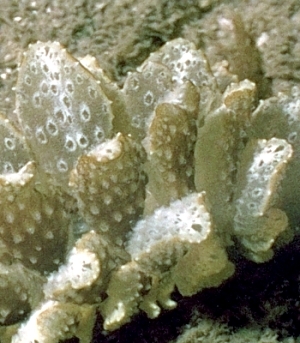Rediscovery of Cyerce pavonina in Tanzania
September 15, 2008
From: Bill Rudman

To accompany some recent messages on species of Cyerce, here is a record of Cyerce pavonina, which I am pretty sure is the first record of the species since its original description from the Philippines 120 years ago (Bergh, 1888). Unfortunately I only found a single animal and as photographic film was hard to obtain the only film available was Agfa slide film which I don't think renders colours accurately and certainly has deteriorated over time. Despite that, if you compare these photos with the painting from Bergh's description [see Fact Sheet], they could have been from the same animal.
Locality: Bahari Beach, 1km N of Kunduchi Beach, Dar es Salaam, Tanzania, 10 August 1975. Length alive 38 mm.Photo: Bill Rudman.
The body is a typical shape for a species of Cyerce with bifurcating rhinophores and the sole of the foot split in two with a transverse groove just behind the rhinophores. The body is mostly covered by large flattened paddle-shaped cerata, which are easily autotomised, and continue to wiggle and exude sticky secretions for many hours after being cast off. In my field notes I record "when touched, the cerata stick to ones fingers and autotomise - they then wriggle around swimming and even 2 days after breaking off are still capable of contracting and changing shape ".
The shape and colour of the cerata is characteristic of the species. The inside face of each ceras [upper side when cerata are lying flat] are translucent clear with many raised transparent pustules scattered all over. Each transparent pustule is surrounded by a white ring, formed from white rice-grain shaped granules standing vertically. The outside face of each ceras [lower side when cerata are lying flat] is an opaque greenish brown colour with scattered slightly raised nodules which are dull whitish in colour. The edge of the cerata has a yellowish band and raised whitish nodules. The ceratal stalk is colourless and on the outer side there are two elongate marks, a black one close to the attachment point and a larger red one further up.
The body is translucent clear a greenish tinge, and scattered microscopic white granules. There is a dark brown band across the head, at eye level, and a lighter brown colour on the oral tentacles and rhinophores. The general colour pattern of the cerata gives the slugs the appearance of a soft coral colony, the outer face looking like contracted polyps while the inner face looks like feeding polyps.
On some websites, a species of Cyerce, which could well be a colour form of what I am calling Cyerce sp. 1, are labelled Cyerce cf. pavonina. They don;t seem to have any if the features I would consider typical of C. pavonina
-
Bergh, L.S.R. (1888) Malacologische Untersuchungen. In: C.G. Semper, Reisen im Archipel der Philippinen, Wissenschaftliche Resultate. Band 2, Heft 16a., 755-814. (Pls. 77-81)
Best wishes
Bill Rudman


Related messages
-
Re: Cyerce cf. pavonina from sthn Queensland
From: Julie Marshall, September 17, 2008 -
Cyerce pavonina? from Reunion Island
From: Philibert Bidgrain, September 17, 2008 -
Re: Rediscovery of Cyerce pavonina in Tanzania
From: Scott Johnson, September 16, 2008 -
Re: Rediscovery of Cyerce pavonina [2]
From: Scott Johnson, September 16, 2008 -
Cyerce sp. 2. from South Africa
From: Ernest C.J. Seamark, March 25, 2000
